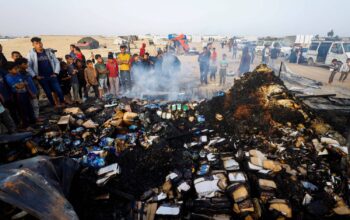‘Serbia against violence’ protesters gathered in Belgrade in front of the National Assembly for the latest anti-government rally on July 1, demanding action from the government and Serbia’s President Aleksandar Vucic after two mass shootings in early May.
This is the ninth time demonstrators have taken to the streets of Belgrade since the first rally on May 8, and the latest protest targeted pro-government broadcaster TV Pink with calls for an end to reality shows that many believe encourage a culture of violence in the country.
Although the crowd gathered slowly, there was a significant increase in numbers compared to the previous protests.
Demonstrations occurred concurrently in 30 other locations, including Nis, Novi Sad, Uzice and Subotica within Serbia, but also Frankfurt, Paris and Brussels.
No more reality TV
The protests started when the shootings — which resulted in the deaths of 18 individuals — led to widespread discontent among the Serbian population but have since broadened as protesters raise a wider range of issues. The protesters accuse the president and the ruling party of fostering a culture of violence through the media and are asking for the dismantling of the responsible regulatory bodies, and a ban on reality shows and journalistic outlets that print fake news and promote violence.
The change of theme for each week has become the staple of the ‘Serbia against violence’ protests. This time, it was announced, the demonstration would campaign for an end to reality TV, and the protesters would march towards TV Pink.
In full numbers
Bojana Novakovic, an Australian actress of Serbian descent, used the occasion to discuss the distinction between violence that has been committed and the rightful outrage of the people.
Following Novkovic, professor Suzana Milutinovic from Cuprija, central Serbia, spoke about the obstacles she faced when standing up to incompetent authorities at the Higher Medical School. She is one of nine women who lost their jobs because they refused to remain silent about changes that were detrimental to their school. “I want people to come back to this country. We have brilliant children and youth. I want them to come back and work here, not somewhere else,” she said at the end.
Emilija Milenkovic, a student from the Faculty of Political Sciences, spoke in support of her colleague Pavle Cicvaric, whose family faced attacks by members of the parliament after he spoke at one of the previous rallies.
The main thoroughfare Knez Milosa has turned into an indicator of the protest’s strength. It appeared that the number of people increased since last’s week march, and once again the protesters filled the entire route, approximately 2km long, from the National Assembly to the Mostar loop on the motorway.
There were no blockades of the international motorway on July 1, instead, there was a pre-protest action on June 30 with two-hour blockades in Novi Sad and Belgrade, that passed without incidents.
Tension brewing
Protesters were accompanied on their march to TV Pink by a truck equipped with a public address system. Someone with a penchant for British punk and rock had been given the authority over the set list.
That gave the march the feeling of an uphill push towards the main stage at a music festival. It was a detail the pro-regime media picked up on, calling the protesters disingenuous, and disrespectful of the victims they were marching for.
As the protesters approached the building of TV Pink, the tension was palpable. Private security personnel were ranged on the balcony of the building next to the main offices.
A constant barrage of whistles and shouting started and went on for 45 minutes. Among the crowd’s calls were “Prison time!” and “It is over”, which were chanted several times during the evening.
The crowd also sang “Zeljko thief!” in a melody most often heard from the sports stands, addressed to Zeljko Mitrovic, owner of the TV station.
The facade of the building was covered by a gigantic Serbian flag. There was scaffolding for the flag and a public address system in front of the building, but it was not used during the protest.
On the white surface of the flag, someone from the protestors’ side projected an image of Oliver Ivanovic. Ivanovic, a political figure from Kosovo, was assassinated shortly after a defamatory video of unknown origin was broadcasted on TV Pink.
At ten past nine, the crowd was still chanting, when radio host Smiljan Banjac asked them to slowly disperse out of consideration for the patients of a nearby hospital. He called on the protesters to engage in small acts of civil disobedience during the following week.
A missed opportunity
Nenad (37), a veterinarian from Belgrade, felt that the energy of the protesters should have brought more to the protest. “We should have done something more tonight, some kind of a performance that could have sent a signal to the wider public,” he said. “It is important that we put pressure on the authorities. They might fulfill some of the demands, but there is still a long way to go.”
Two Partizan supporters, who wished to remain anonymous, shared these sentiments. “[These] people think something can be done with shouting”, one of them said, “this is elementary school stuff.”
“Radicalise, radicalise, radicalise,” the other added.
Despite calls for radicalisation, the protests appear to be on a steady course and could continue to the next election, which some political parties believe will take place in the autumn.
Source: Intelli News




